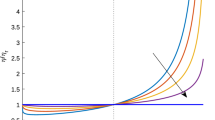Abstract
We obtain conditions for the existence of an invariant distribution on (0, ∞) for stochastic growth models of Ito type. We interpret the results in the case where the intrinsic growth rate is adjusted to account for the impact of a toxicant on the population. Comparisons with related results for ODE models by Hallamet al. are given, and consequences of taking the Stratonovich interpretation for the stochastic models are mentioned.
Similar content being viewed by others
Literature
Butler, G., H. I. Freedman and P. Waltman. 1986. Uniformly persistent systems.Proc. Am. math. Soc. 96, 425–430.
DeAngelis, D. L., R. A. Goldstein and R. V. O'Neill. 1975. A model for trophic interaction.Ecology 56, 881–982.
Gallopin, G. C. 1971. A generalized model of a resource-population system: I. General properties. II. Stability analysis.Oecologia 7, 382–413;7, 414–432.
Gard, T. C. 1988.Introductions to Stochastic Differential Equations. New York: Marcel Dekker.
Gard, T. C. 1990. A stochastic model for the effects of toxicants on population.Ecol. Modelling 51, 273–280.
Goel, N. S. S. C. Maitra and E. W. Montroll. 1971 On the Volterra and other nonlinear models of interacting populations.Rev. Mod. Phys. 43, 231–276.
Gompertz, B. 1925. On the nature of the function expressive of the law of human mortability.Phil. Trans. 115, 513–585.
Hallam, T. G. 1986. Population dynamics in a homogeneous environment. InMathematical Ecology, T. G. Hallam and S. A. Levin (Eds). Berlin: Springer-Verlag.
Hallam, T. G. and Ma Zhien. 1986. Persistence in population models with demographic fluctuations.J. math. Biol. 24, 327–339.
Ma Zhien Song Baojun and T. G. Hallam. 1989. The threshold of survival for systems in a fluctuating environment.Bull. math. Biol. 51 311–323.
Rosenzweig, M. 1971. The paradox of enrichment: destabilization of exploitation ecosystems in ecological time.Science 171, 385–387.
Smith, F. E. 1963. Population dynamics in Daphnia magna and a new model for population growth.Ecology 44, 651–663.
Vance, R. R. 1990. Population growth in a time-varying environment.Theor. Pop. Biol. 37, 438–454.
Vance R. R. and E. A. Coddington. 1989. A nonautonomous model of population growth.J. math. Biol. 27, 491–506.
Wong, E. and M. Zakai. 1965. On the convergence of ordinary integrals to stochastic integrals.Ann. math. Stat. 36, 1560–1564.
Author information
Authors and Affiliations
Rights and permissions
About this article
Cite this article
Gard, T.C. Stochastic models for toxicant-stressed populations. Bltn Mathcal Biology 54, 827–837 (1992). https://doi.org/10.1007/BF02459932
Received:
Issue Date:
DOI: https://doi.org/10.1007/BF02459932



